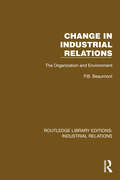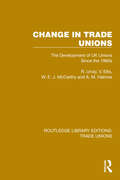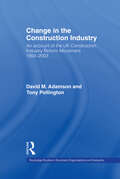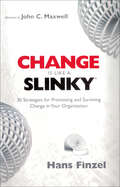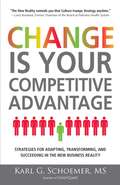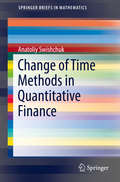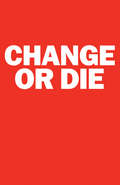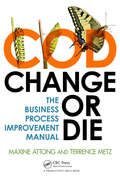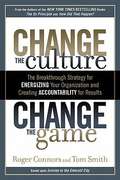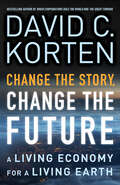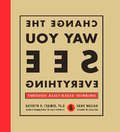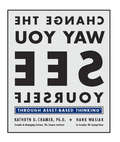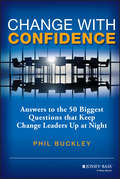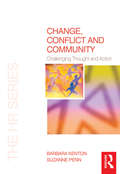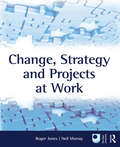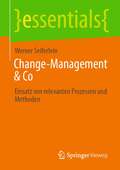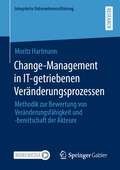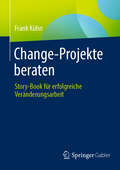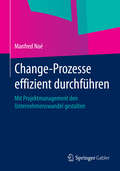- Table View
- List View
Change in Industrial Relations: The Organization and Environment (Routledge Library Editions: Industrial Relations)
by P.B. BeaumontChange in Industrial Relations (1990) examines the industrial relations system in the UK at the end of the 1980s, after a decade of changes such as the growth of non-union firms, trade union decline, the emergence of human resource management practices, and increase in labour–management co-operation. The author describes the major features of the system and discusses the recent changes, drawing on insights from economics, organizational behaviour, and urban and regional research, as well as from the traditional literature of industrial relations. Focusing on collective bargaining, he examines the practices of the British system of industrial relations in recent years, and places the UK in a wider context by providing facts and figures for other national systems, in particular making extensive reference to developments and research in the USA.
Change in Trade Unions: The Development of UK Unions Since the 1960s (Routledge Library Editions: Trade Unions #20)
by W. E. McCarthy R. Undy V. Ellis A. M. HalmosOriginally published in 1981, this book explains the factors which precipitated and effected changes in the major dimensions of union activity in Britain since 1960. The authors use a series of comparative case studies to examine change in the government, growth, mergers, character and bargaining structures of British unions. The central theme of the book is that unions are far freer to determine their own behaviour than was commonly supposed. In examining changes in unions, the authors develop concepts and terms which provide new insights into union behaviour.
Change in the Construction Industry: An Account of the UK Construction Industry Reform Movement 1993-2003 (Routledge Studies in Business Organizations and Networks #Vol. 36)
by David M. Adamson Anthony H. PollingtonThe UK construction industry is the sixth largest industry in the UK in terms of turnover. During the last decade, it has undergone an unprecedented period of self-examination, including input from most of the leaders of the major suppliers and clients as well as from leading politicians, civil servants and political advisers. From 1993 to 2003, government and industry collaborated closely to achieve political and structural change in the industry and to bring about nothing less than a re-organization of the way it undertakes its business. This key text is an objective presentation of the critical issues inherent in the construction industry during this time. Providing invaluable source material for students of government/industry relations, industry practitioners and clients, and for economic and social commentators, this valuable resource draws on revealing personal accounts from politicians, civil servants, advisers and industry leaders, as well as factual reportage, archives and official papers of the period. Informative and enlightening, this book objectively details and documents exactly what happened at this time, and the reasons for it, and offers an unbiased interpretation of the successes or failures of the various initiatives that emerged, including the Movement for Innovation, Rethinking Construction and Constructing Excellence.
Change is Like a Slinky: 30 Strategies for Promoting and Surviving Change in Your Organization
by Hans FinzelA practical guide to navigate change in today's organizational climate. Change or perish: this is a current motto for leaders in all types of organizations. But how does one adapt to such fast and furious change and effectively lead the organization through change intact and more effective? Hans Finzel provides a proven strategy in Change is Like a Slinky, exploring the six major phases in the cycle of change. As he says, 'Change is a lot like a Slinky... A slinky can be a lot of fun, but it is also completely unpredictable.' Instead of grudgingly wading through inevitable change, readers will find themselves equipped and fired up to tackle it head on.
Change is Like a Slinky: 30 Strategies for Promoting and Surviving Change in Your Organization
by Hans FinzelA practical guide to navigate change in today's organizational climate. Change or perish: this is a current motto for leaders in all types of organizations. But how does one adapt to such fast and furious change and effectively lead the organization through change intact and more effective? Hans Finzel provides a proven strategy in Change is Like a Slinky, exploring the six major phases in the cycle of change. As he says, 'Change is a lot like a Slinky... A slinky can be a lot of fun, but it is also completely unpredictable.' Instead of grudgingly wading through inevitable change, readers will find themselves equipped and fired up to tackle it head on.
Change is Your Competitive Advantage
by Karl G SchoemerOrganizations today face a stark choice: change or fail. Transformation has become the only constant of the business landscape, and those companies that cannot adapt are doomed. But Karl Schoemer's New Reality program is here to help businesses make the tough choices that will lead to success. This book iincludes practical tools to help managers and employees:Adapt to changeIdentify Design/Defiant/Default behaviorsCreate a culture focused on the needs of the customer and consumerThis book includes case studies and anecdotes from Schoemer's clientele and positions executives and employees to make the most out of every change their company encounters.
Change is Your Competitive Advantage
by Karl G. SchoemerOrganizations today face a stark choice: change or fail. Transformation has become the only constant of the business landscape, and those companies that cannot adapt are doomed. But Karl Schoemer's New Reality program is here to help businesses make the tough choices that will lead to success. This book iincludes practical tools to help managers and employees: Adapt to change Identify Design/Defiant/Default behaviors Create a culture focused on the needs of the customer and consumer This book includes case studies and anecdotes from Schoemer's clientele and positions executives and employees to make the most out of every change their company encounters.
Change is Your Competitive Advantage: Strategies for Adapting, Transforming, and Succeeding in the New Business Reality
by Karl G SchoemerOrganizations today face a stark choice: change or fail. Transformation has become the only constant of the business landscape, and those companies that cannot adapt are doomed. But Karl Schoemer's New Reality program is here to help businesses make the tough choices that will lead to success. This book iincludes practical tools to help managers and employees:Adapt to changeIdentify Design/Defiant/Default behaviorsCreate a culture focused on the needs of the customer and consumer This book includes case studies and anecdotes from Schoemer's clientele and positions executives and employees to make the most out of every change their company encounters.
Change of Time Methods in Quantitative Finance (SpringerBriefs in Mathematics)
by Anatoliy SwishchukThis book is devoted to the history of Change of Time Methods (CTM), the connections of CTM to stochastic volatilities and finance, fundamental aspects of the theory of CTM, basic concepts, and its properties. An emphasis is given on many applications of CTM in financial and energy markets, and the presented numerical examples are based on real data. The change of time method is applied to derive the well-known Black-Scholes formula for European call options, and to derive an explicit option pricing formula for a European call option for a mean-reverting model for commodity prices. Explicit formulas are also derived for variance and volatility swaps for financial markets with a stochastic volatility following a classical and delayed Heston model. The CTM is applied to price financial and energy derivatives for one-factor and multi-factor alpha-stable Levy-based models. Readers should have a basic knowledge of probability and statistics, and some familiarity with stochastic processes, such as Brownian motion, Levy process and martingale.
Change or Die
by Alan DeutschmanChange or Die. What if you were given that choice? If you didn't, your time would end soon--a lot sooner than it had to. Could you change when change matters most? This is the question Alan Deutschman poses in Change or Die, which began as a sensational cover story by the same title for Fast Company. Deutschman concludes that although we all have the ability to change our behavior, we rarely ever do. From patients suffering from heart disease to repeat offenders in the criminal justice system to companies trapped in the mold of unsuccessful business practices, many of us could prevent ominous outcomes by simply changing our mindset. A powerful book with universal appeal, Change or Die deconstructs and debunks age-old myths about change and empowers us with three critical keys--relate, repeat, and reframe--to help us make important positive changes in our lives. Explaining breakthrough research and progressive ideas from a wide selection of leaders in medicine, science, and business (including Dr. Dean Ornish, Mimi Silbert of the Delancey Street Foundation, Bill Gates, Daniel Boulud, and many others), Deutschman demonstrates how anyone can achieve lasting, revolutionary changes that are positive, attainable, and absolutely vital.
Change or Die: The Business Process Improvement Manual
by Maxine Attong Terrence MetzLeadership success depends on clarifying and simplifying complex problems while maintaining a positive outlook. Change or Die - The Business Process Improvement Manual provides you with the tools to do so. Packed with more than 70 pages of workshop tools, agendas, and activities that detail each of the six stages of the business process improvement (BPI) method, it presents a BPI method that promotes the use of facilitator-led workshops to help you and your team make better decisions. Developed from empirical research and bolstered by the results of client experience from hundreds of hours of facilitated workshops and BPI activity, Change or Die employs the authors' ENGAGE methodology. To ensure your team achieves its deliverables, the authors walk you through each BPI method. In each chapter you will find: Objectives and deliverables clearly identified Real-world examples from companies the authors have worked with—presented using a global manufacturer as an example Activities, questionnaires, and examples A self-assessment tool to help you measure progress, identify gaps in team performance, and determine team readiness for the next stage This resource-rich book includes downloadable resources with supplemental activities, challenges, facilitated workshops, templates, tables, and questionnaires—tools designed to ease each participant’s path to project success.
Change or Die?: An Evidence-Based Approach to Change Management
by Robert I. Sutton Jeffrey PfefferThis chapter examines the faulty evidence and logic behind the mantra "change or die," the related half-truth that change is difficult and takes a long time, and describes what organizations can do to speed change.
Change the Culture, Change the Game
by Roger Connors Tom SmithA fully revised and updated installment from the bestselling author of The Oz Principle Series. Two-time New York Times bestselling authors Roger Connors and Tom Smith show how leaders can achieve record-breaking results by quickly and effectively shaping their organizational culture to capitalize on their greatest asset-their people. Change the Culture, Change the Game joins their classic book, The Oz Principle, and their recent bestseller, How Did That Happen?, to complete the most comprehensive series ever written on workplace accountability. Based on an earlier book, Journey to the Emerald City, this fully revised installment captures what the authors have learned while working with the hundreds of thousands of people on using organizational culture as a strategic advantage. .
Change the Story, Change the Future: A Living Economy for a Living Earth
by David C. KortenWe humans live by stories, says David Korten, and the stories that now govern our society set us on a path to certain self-destruction. In this profound new book, Korten shares the results of his search for a story that reflects the fullness of human knowledge and understanding and provides a guide to action adequate to the needs of our time.Korten calls our current story Sacred Money and Markets. Money, it tells us, is the measure of all worth and the source of all happiness. Earth is simply a source of raw materials. Inequality and environmental destruction are unfortunate but unavoidable. Although many recognize that this story promotes bad ethics, bad science, and bad economics, it will remain our guiding story until replaced by one that aligns with our deepest understanding of the universe and our relationship to it.To guide our path to a viable human future, Korten offers a Sacred Life and Living Earth story grounded in a cosmology that affirms we are living beings born of a living Earth itself born of a living universe. Our health and well-being depend on an economy that works in partnership with the processes by which Earth's community of life maintains the conditions of its own existence—and ours. Offering a hopeful vision, Korten lays out the transformative impact adopting this story will have on every aspect of human life and society.
Change the Way You Form Your Assumptions: Base Views of Customers on Facts, Not Conventional Wisdom to Uncover Sources of Additional Profit
by Hermann Simon Frank F. Bilstein Frank LubyChallenging and changing your existing assumptions about your customers is the most important first step in identifying your hidden profit opportunities. It is always easier to retool your thinking-your assumptions about what your customers want and are willing to pay-than to retool the actual products and services you offer. This chapter explains the dangers inherent in using gut feeling, anecdotal evidence, and other corporate shortcuts to guide your decision making, and uses the links between price and profit to demonstrate the advantages of data-driven analysis.
Change the Way You See Everything through Asset-Based Thinking: Through Asset-based Thinking
by Hank Wasiak Kathryn D. CramerThis brilliantly simple book on the philosophy known as Asset-Based Thinking, instills success-oriented habits in even the most die-hard cynic. Its transformational lessons--conveyed through unique photographic metaphors and inspiring stories from real people--reveal how the slightest shift in perception can lead to monumental results in both business and in life. ABT is not just positive thinking, but rather a systematic observation of "what works." Kathryn Cramer, an acclaimed corporate consultant, and Hank Wasiak, a creative icon of the advertising industry, have produced a work that looks and works like no other business or self-help book-because it IS like no other book. Change the Way You See Everything is a revolutionary approach to every aspect of life that bears not just reading, but re-reading, and sharing with people in your circle. You'll never look at the world the same way again.
Change the Way You See Yourself
by Hank Wasiak Kathryn D. CramerSmall shifts in thinking lead to big rewards - that's the empowering lesson of Asset-Based Thinking. Now, let the power of ABT help change the way you perceive yourself and your ability to change the world around you. <P><P>By transforming the way you see your own POWER, your INFLUENCE grows exponentially and your personal IMPACT intensifies dramatically
Change with Confidence
by Phil BuckleyPraise for CHANGE WITH CONFIDENCE "Phil Buckley is a world-class change leader and world-champion enthusiast for effective change management. Straightforward and engaging, Phil addresses the 50 questions all change managers need to answer with confidence in order to succeed. Rare too for an author in this field, he shares the 'how-not-to' as well as the 'how-to.' This is a book any manager wanting to succeed in change should keep close by."-- Professor Chris Bones, Dean Emeritus, Henley Business School; Professor of Leadership, University of Manchester; and award-winning author of The Cult of the Leader "Phil Buckley's book gives excellent, practical advice on how to implement change in any private or public organization. What makes Change with Confidence so special is that it is organized around questions that anybody who is engaged in or leading change management will find to be key to their success. The real-life examples given for each question make this a very readable book. A must-buy for anybody who wants to avoid the most common mistakes in change management."-- Stefan A. Bomhard, President, Europe, Bacardi Martini Group "Change with Confidence provides leaders and leaders of change with a wealth of knowledge and experience that they can apply to their own change initiatives, and the real-world examples provide additional clarity on how to successfully manage or avoid common pitfalls."-- David Sculthorpe, CEO, Heart and Stroke Foundation of Canada Change Management is about helping people decide to change successfullyIf you have been charged with leading a change initiative, chances are you were chosen for the job--that is, you didn't volunteer, but rather were tapped to lead or manage a large change project. You may have been given a short briefing and left to your own devices to succeed or fail in an uncertain, often threatening, environment. You may find yourself struggling to adapt your skill set to unfamiliar and anxiety-inducing conditions, conscious that your performance will affect your future career paths.Change with Confidence addresses the 50 biggest questions that change leaders ask time and again, and provides the context, examples, and advice to answer them well, and to enable successful, sustainable change. Whether you're trying to figure it out, are in the planning stage, are actively managing or are working to make it stick, you'll find guidance for a wide range of issues, including:Analyzing previous change initiatives to see what worked, what didn't, and whyFinding out who can influence your success or failure, help you, or trip you upDetermining what resources you'll need and how to get themOvercoming change fatigue and opposition to change.Although every change has its own circumstances, there are proven processes, tactics, and behaviors that lead to lasting success. Change with Confidence offers practical, experience-based advice on a difficult and stressful challenge.
Change, Conflict and Community
by Barbara Kenton Suzanne PennThe cost to business of unresolved conflicts is high; tribunals, loss of productivity, resignations and damaged reputations are serious consequences for all concerned. With increased organizational change in the form of changes in leadership, restructuring, downsizing, matrix management, mergers, acquisitions and systems changes comes increased political activity and the potential for either increased learning and growth or tension and unproductive conflict.Change agents, HR practitioners and managers need to be skilled at empowering others to use or resolve conflict effectively for a more productive working environment and greater employee satisfaction. Change, Conflict and Community takes readers through the essential theory and hands-on practice of working with change and conflict by considering:* How we can increase our understanding of the tensions that often exist when change is ever present in the organization* How to work more effectively with the dynamic relationship between change and conflict* How the idea of “community” can help us to work with the energy of change and human interactionBarbara Kenton is a freelance consultant and Director of WHooSH Whole Systems Health. She is an experienced consultant, mediator, facilitator, coach and trainer with over 25 years' experience as a manager and development specialist working with individuals, teams and organizations both in the UK and internationally. She has published a number of articles on the role of the internal consultant and challenges facing those in HR. She is a qualified workplace and community mediator.Suzanne Penn is an independent consultant, facilitator and coach with 20 years' experience in the HR and Organization Development field. She has worked as an internal and an external practitioner across all sectors and industries in the UK, mainland Europe and the US. A previous Assistant Director at Roffey Park Management Institute, she brings to this book particular expertise in leadership development, group facilitation, strategic HR and organizational change and culture. The HR SeriesThe HR Series is edited by Julie Beardwell, Principal Lecturer in Human Resource Management at DeMonfort University, and Linda Holbeche, Director of Research and Policy at CIPD, and is designed to plug the gap between theory and implementation. The books draw on live examples of strategic HR in practice and offer practical insights into how to transform individual and functional delivery to improve value-added. Intended for serious HR professionals who aspire to make a real difference within their organization, The HR Series provides resources to inform, empower and inspire the HR leaders of the future.
Change, Strategy and Projects at Work
by Roger Jones Neil MurrayChange, Strategy and Projects at Work provides a working insight into the nature of change, the formulation of strategy and the implementation of change through projects in the workplace. It is a ‘how to’ book with real practical application, containing the tools, techniques, advice and guidance you need to analyse organisational context, develop a strategic plan and manage a project. To help you in leading change and creating opportunities for yourself and your organisation, the book takes an integrated approach to managing change, developing strategy and project management, and covers: * How strategic objectives are chosen, promoting awareness of the wider organisational context and the strategic planning process* The knowledge, tools, techniques and confidence needed to act as a change agent * The skills, competencies and other attributes needed to improve your employabilityThe book is ideal as a dip-in guide for professional development, a self-study resource or a textbook for formal courses on change, strategy and project management in a work context. It is used to support the Open University’s undergraduate course ICTs, Change and Projects at Work (T226).
Change-Dazed Manager
by Tim HavensGeorge Stanton helped build Sannas Pharmaceuticals in his six years there, and when he is promoted to vice president and director of risk management, he thinks he is set for life. But then a new president is appointed, and George can't tolerate his shady practices. Atwater-Jordan looks like a better company, and George is impressed with Joan, his potential new boss. So he takes the job, even though it means moving his family and asking his wife to change her job too. But within a few months, Joan's flaws start showing up: she does all the talking at meetings; she doesn't give George information he needs; and she wants to control everything he does. Other people at Atwater call her "Phony Joanie," but when George discusses the problem with the company president, Harold doesn't help. "I'm sure you can handle her and keep her off other people's backs," he tells George. Facing a new year's resolution to try to solve the Joan problem, George doesn't know where to start. He wonders if there's something wrong with him or if he's just having bad luck. HRM and relocation experts give their views.
Change-Management & Co: Einsatz von relevanten Prozessen und Methoden (essentials)
by Werner SeiferleinOrganisationen ändern sich nicht nur aufgrund neuerer Systeme, Prozesse oder neuer Organisationsstrukturen. Sie ändern sich, weil sich auch die Mitarbeiterinnen und Mitarbeiter innerhalb der Organisation anpassen und ändern. Nur wenn die Menschen darin ihre eigenen persönlichen Übergänge gemacht haben, kann eine Organisation wirklich von den Vorteilen des Wandels profitieren. Dieses Essential legt das Hauptaugenmerk auf Gesundheit und Wohlbefinden der Menschen in einem Unternehmen. Hierzu werden die planerisch beeinflussbaren gesundheitsrelevanten Faktoren betrachtet, die in einem Büro- bzw. Verwaltungsgebäude auf die Mitarbeiterinnen und Mitarbeiter wirken und deshalb in der Planung besondere Aufmerksamkeit benötigen. Will man sich kurz und knapp über das Thema Prozesse und Methode zur Implementierung von Wohlbefindlichkeit informieren, ist dieses Essential die geeignete Basis.
Change-Management in IT-getriebenen Veränderungsprozessen: Methodik zur Bewertung von Veränderungsfähigkeit und -bereitschaft der Akteure (Integrierte Unternehmensführung)
by Moritz HartmannDer Erfolg von IT-getriebenen Veränderungsprozessen wie IT-Systemimplementierungen hängt maßgeblich von der Veränderungsfähigkeit und -bereitschaft der gestaltenden Akteure ab. Aufgrund der unterschiedlichen Nähe der Akteure auf Business- und IT-Seite zum implementierten IT-System ist jedoch oft eine asymmetrische Veränderungsfähigkeit und -bereitschaft dieser Akteure vorzufinden. Daher wird eine implementierungsreife Evaluationsmethode entwickelt, die im Zuge eines Change-Managements Transparenz über die Veränderungsfähigkeit und -bereitschaft der gestaltenden Akteure auf Business- und IT-Seite schaffen kann. Mithilfe dieser für Praktikerinnen und Praktiker aufbereiteten Evaluationsmethode lassen sich in Bezug auf das Kennen, Können, Sollen, Dürfen und Wollen unternehmensindividuelle „Stellschrauben“ identifizieren und einstellen.
Change-Projekte beraten: Story-Book für erfolgreiche Veränderungsarbeit
by Frank KühnIn diesem Fachbuch beschreibt Frank Kühn basierend auf seiner langjährigen Erfahrung als Berater verschiedene Change-Situationen in fiktiven Unternehmen. Informativ und kurzweilig tauscht er sich zu diesen mit seinen – ebenfalls fiktiven – Beraterkollegen aus und stellt so die Beratungssituationen unter verschiedenen Gesichtspunkten und mit unterschiedlichen Ansätzen dar. Frank Kühn plädiert für eine verantwortungsvolle Beratung, welche die praktischen Bedürfnisse, realen Möglichkeiten und vor allem die erfolgsrelevanten Situationen in Unternehmen und Veränderungsprozessen berücksichtigt. Dabei ist ihm der Austausch auf Augenhöhe sowohl zwischen Management und Beratern als auch zwischen Managern und Mitarbeitenden wichtig. Die gewählte Beratersicht ist auch für Verantwortliche in Unternehmen schnell nachvollziehbar und in konkreten Situationen im eigenen Unternehmen leicht anwendbar. Der Autor schildert keine aufwändigen Konzepte, sondern setzt auf gemeinsame kreative Entwicklung und schnelles Beginnen. So ist das Buch sowohl für interne und externe Berater als auch für die Verantwortlichen auf den verschiedenen Ebenen der Unternehmen ein hilfreiches Lese- und Arbeitsbuch.
Change-Prozesse effizient durchführen: Mit Projektmanagement den Unternehmenswandel gestalten
by Manfred NoéDieses Werk zeigt allen, die Veränderungen in Unternehmen initiieren, leiten und begleiten, wie Organisationen sich so organisieren sollten, dass notwenige Veränderungen schnell erkannt und durchgeführt werden. Die effektive Realisierung von Change-Prozessen und die Umsetzung der Ergebnisse entscheiden darüber, ob ein Unternehmen in einem sich schnell verändernden Umfeld die Kontrolle behält oder verliert. Manuelle Prozesse, funktionsorientierte unflexible Strukturen und veraltete Strategien wirken sich langfristig negativ auf die Wettbewerbsfähigkeit aus. Mithilfe eines ganzheitlichen Konzeptes wird gezeigt, wie Veränderungsvorhaben mit einem professionellen Projektmanagement effizient durchgeführt werden. Nur wer in der Lage ist, diesen vorgestellten Change-Prozess als festen Bestandteil des Unternehmenswandels zu begreifen, zu gestalten und entsprechend einzusetzen, wird dauerhaft erfolgreich sein.
